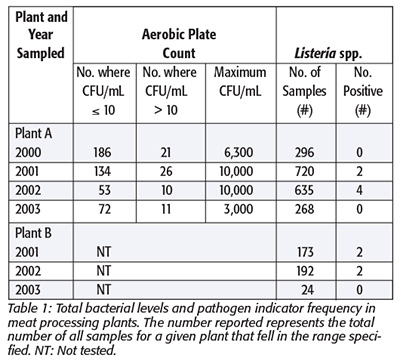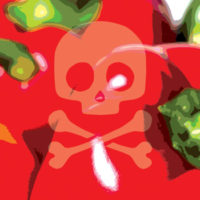Wherever one finds adjacent surfaces or areas that have different temperatures, or where relative humidity is very high, condensation can form. Temperature differentials and high humidity in the food processing industry are prevalent, with the exception of some dry ingredient or product plants. I come from the processed meat industry, where condensation is an everyday issue, fluctuating seasonally in severity. While condensation in food production facilities is a common occurrence and is regarded unfavorably by most regulatory and food safety accreditation bodies, what truly are the hazards associated with condensation and how serious is the threat it poses? This article explores whether incidental condensation coming into contact with either raw or ready-to-eat (RTE) products, and by extension, food contact surfaces, creates a hazard in the product and truly represents creation of an insanitary condition (unclean enough to endanger health).
I have divided this discussion into two types of manufacturing environments based on finished product characteristics and process flow through the production facility. The first type I will call raw manufacturing, because the products in this environment typically receive further processing somewhere else in the facility, are further processed by some other manufacturer or will receive some treatment by the end-user prior to consumption. Auditing bodies often call this area a low-risk environment. The other type of manufacturing area I will call the RTE area or high-risk environment, because product leaving this area may be consumed without further preparation. And to further set the stage for this discussion, I define condensation as the development of pure (i.e., distilled) water droplets on hard surfaces as a result of water vapor in the air phase changing to liquid on surfaces that are colder than the dew point of the surrounding air. These pure water droplets are typically less than 5 mm in diameter and weigh about 0.12 g.
Raw Manufacturing Area
Physical: Physical hazards result from consumption of hard or sharp objects that cause a blockage, laceration, perforation or wound in the subject. The U.S. Food and Drug Administration (FDA)’s extensive review of the scientific literature concerning physical hazards in food[1] shows that objects smaller than 7 mm represent minimal hazards to consumers. Due to its extremely small mass, a drop of water resulting from condensation in a food plant does not have the physical capacity to erode or remove substantial surface particles. Because condensation drops are typically smaller than 5 mm in diameter, it is highly unlikely that they would carry within them hard or sharp objects equal to or greater than 7 mm. Therefore, I conclude that it is extremely unlikely that condensation falling into (or onto) a food product in process or equipment would result in the introduction of a physical hazard.
 Biological: Biological hazards in normally safe foods result from pathogens or byproducts of pathogen growth being present at numbers or levels sufficient to cause an adverse health response. It is unlikely that bacterial pathogens that produce toxins will do so on overhead surfaces, as growth requirements (nutrients, for example) on these surfaces in food plants would not support the high pathogen populations typically necessary for toxin production. In fact, several years of testing condensation droplets for general bacterial numbers from two of our meat processing facilities have yielded low colony counts, and concurrent testing showed pathogen indicator organisms present at low frequencies (see Table 1). While unlikely, it is possible that pathogens themselves could be present in or on overhead structures and be carried into food products via condensation. If condensation that could be carrying a pathogen fell on raw product that was unlikely to receive a lethality treatment either at the facility or somewhere downstream prior to consumption (particularly if the product were held under conditions favorable for pathogen growth), then this product would have to be redirected to a pathogen-reduction step, reconditioned if possible or discarded. But if condensation fell onto product prior to a cook or other lethality step, and the lethality step were designed to destroy all pathogens of concern present in the raw product, this step would completely control the biological contamination introduced by condensation. Thus, there would be no biological hazard of concern in the finished product and the condensation contamination would be insignificant.
Biological: Biological hazards in normally safe foods result from pathogens or byproducts of pathogen growth being present at numbers or levels sufficient to cause an adverse health response. It is unlikely that bacterial pathogens that produce toxins will do so on overhead surfaces, as growth requirements (nutrients, for example) on these surfaces in food plants would not support the high pathogen populations typically necessary for toxin production. In fact, several years of testing condensation droplets for general bacterial numbers from two of our meat processing facilities have yielded low colony counts, and concurrent testing showed pathogen indicator organisms present at low frequencies (see Table 1). While unlikely, it is possible that pathogens themselves could be present in or on overhead structures and be carried into food products via condensation. If condensation that could be carrying a pathogen fell on raw product that was unlikely to receive a lethality treatment either at the facility or somewhere downstream prior to consumption (particularly if the product were held under conditions favorable for pathogen growth), then this product would have to be redirected to a pathogen-reduction step, reconditioned if possible or discarded. But if condensation fell onto product prior to a cook or other lethality step, and the lethality step were designed to destroy all pathogens of concern present in the raw product, this step would completely control the biological contamination introduced by condensation. Thus, there would be no biological hazard of concern in the finished product and the condensation contamination would be insignificant.
Chemical: While most plants’ overhead structures are cleaned on a routine schedule, they usually are not subject to the frequent sanitation that the food handling equipment itself receives and may be made of materials not normally considered suitable for direct food contact. Therefore, these structures may be coated with airborne contaminants or made of materials that would lead to adverse health impacts if consumed at high enough levels. If either of these situations exists, condensation from overhead structures could carry these chemicals into food materials if the condensation fell onto food or food contact surfaces.
It is unlikely that any materials used in food plant overhead structures or airborne chemicals that have been deposited on overhead structures contain known toxicants. But we cannot know with certainty all of the chemicals that are present on overhead materials. We therefore will use a general knowledge of the toxicity of substances in our chemical Hazard Analysis to predict whether a hazard is likely to exist. FDA toxicologists have evaluated a tremendous number of chemicals for their toxic effects and levels required for an adverse health consequence,[2] and they have shown that the required oral dose for toxic effects for almost all chemicals is at least 1 mg of substance for each kg of body weight (1 mg/kg). Most toxicants require much higher doses than this threshold level for deleterious effects.
Using the above value as a guide, we can predict, by constructing worst-case scenarios, the likelihood of a chemical hazard existing in food in process that was subject to condensation, even if we do not know what chemicals were present in the condensation. In the case of condensation falling into one of our vats or combos of meat or emulsion (2,000 pounds), let’s assume eight drops fall into the container. This represents about 1 g of condensate. If we also assume that this water contains 10 percent by weight of a single hazardous chemical that originated on an overhead structure, this condensation event would deliver 0.1 g of this chemical (1 g water × 0.1). Thus, the resulting concentration of this chemical in the combo would be 0.1 part per million (ppm) (0.1 g/2,000 lb × 1 lb/454 g). Furthermore, we estimate that the smallest child likely to consume products from this plant would weigh 10 kg (~22 lb or about 1 year old). Using the worst-case toxicity figure from above of 1 mg/kg, this child would have to consume 10 mg of a toxic chemical to suffer any adverse health effects. Because we have calculated that this contaminated meat product contains an unknown toxicant at 0.1 ppm, the child would have to consume 220 pounds of this meat product (10 mg/0.1 ppm in the product = 108 mg or 100 kg) in a 24-hour period to ingest enough of this contaminant for any noticeable effect. Of course, consumption at this level is totally impracticable. An increase in the body weight of a consumer would result in a proportional increase in product consumption required for an adverse effect.
Using the same toxicity considerations from above, if the 1 mL of condensation instead fell on a 26-lb stick of bologna prior to the cook step, and the condensation and its dissolved toxicant were absorbed completely into the bologna, the bologna would be contaminated at a level of 8.5 ppm (0.1 g/26 lb × 1 lb/454 g) with this unknown chemical. As noted before, a small child would need to consume 10 mg of this substance to get ill, which means that they would have to consume 2.6 lb of this product in one day (10 mg/8.5 ppm = 1.2 × 106 mg or 1.2 kg). Adults would obviously have to consume more to achieve the equivalent dose of 1 mg/kg of body weight. This also seems very unlikely. Condensation falling on and being absorbed by smaller products would also undergo the same analysis to determine health risk.
This exploration of the potential chemical hazard from condensation falling on/into product has been based on several worst-case scenarios that are unlikely in most food plants. For example, it is unlikely that the droplets would contain 10 percent by weight of a toxicant from the overheads, as most human toxicants are not that soluble in water. It is equally unlikely that we would find chemicals in our plants that are at the very high end of the toxicity scale (1 mg/kg). And it is also unlikely in the case of stuffed or cased product ready for the cook step that 1 mL of condensation would fall on a single item or that the chemical carried by condensation would be absorbed entirely by the product within. On the other hand, if condensation does fall on product and the chemical contaminant carried by the droplet(s) is absorbed completely into the food item and remains localized near the contact point, a consumer could get a higher dose. Each individual producer will have to evaluate the likelihood of where condensation can occur in the production process, what food would be impacted, whether the contaminant would be spread over a large amount of product or be localized and whether any further process steps would reduce or increase the threat.
We have also considered the impact of a carcinogen as the chemical contaminant. Carcinogens can exert their effects on cells at lower levels than 1 mg/kg, but their effects usually require repeated contact with the carcinogen over a lengthy period. We would not expect, nor permit, repeated, long-term product contact with condensation in our plants. As a result of this toxicological examination, we have determined that a chemical hazard in raw products is not reasonably likely to occur as a result of incidental condensation contacting product.
RTE Area
Chemical and Physical: The potential for introduction of chemical and physical hazards from contact with condensation in RTE products during processing would be very similar to the potential of these hazards in the raw manufacturing area, that is, not reasonably likely to occur. But keep in mind two factors in the RTE environment that may increase the risk of a chemical hazard: There is less likelihood that a remediation step (trimming, washing) could be taken, and the product sizes tend to be much smaller, which raises the concentration of the toxicant within the product presented to the consumer.
Biological: For fully cooked products or products that otherwise go through a pathogen-reduction step, condensation can act as a point source of pathogens if it comes into contact with product postlethality. As mentioned previously, overhead structures in the plant environment are generally not conducive to growth of pathogens, but pathogens could be present at low levels. If this product is distributed in a well-maintained cold chain, Listeria monocytogenes is the only foodborne pathogen that conceivably would grow to high levels prior to consumption. Unfortunately, some pathogens that exhibit poor growth at refrigeration temperatures, like Salmonella and pathogenic Escherichia coli, have a low infective dose and would not have to replicate during distribution to represent a potential hazard. This would also be the case where condensation (introduction of a pathogen) fell on product that does not support the growth of pathogens, no matter what the distribution conditions are. You can see from our overhead sampling in Table 1 that in our plants, it seems unlikely that pathogens are present on the overhead structures, but we really can’t rule it out. Unless a producer has considerable direct evidence of a lack of pathogens on overhead surfaces, they must assume a pathogen could be present. Therefore, any RTE product that comes into contact with condensation before packaging must be discarded or undergo a surface pathogen-reduction process to destroy potential surface contamination with microorganisms (don’t forget, shelf life may be affected even though no hazardous organisms were present in condensation). This pathogen-reduction step can be much milder than the original process, as we need to treat only the surface, if possible, with a 2- to 3-log reduction. After product has been placed into a package that will prevent direct contact with condensation, the biological hazard no longer exists.
Conclusions
I have witnessed many instances where regulatory representatives and food safety auditors have assumed that condensation is a serious food safety hazard that must be avoided at all costs. An actual analysis of the potential hazards of condensation presents a different case. Chemical and physical hazards associated with condensation contamination are unlikely, and assessment of the severity of the hazard is based on the presence of pathogens and subsequent processing. In fact, if an overhead structure where condensation forms and falls from is nonporous and routinely sanitized, there is no food safety hazard introduced by this condensation falling on product or food contact surfaces. This is not the same as ignoring condensation, as its formation is an indication of a facility design or operational issue. But we as producers of foods and those that regulate us and audit us should make rational choices about the myriad sources of hazards associated with producing food, and focus our efforts where they are truly needed.
Gene W. Bartholomew, Ph.D., is corporate director of food safety/Hazard Analysis and Critical Control Points (HACCP) affairs at Smithfield Foods. He provides direction, technical expertise and consultation to the company’s slaughter and meat processing plants and one spice plant in the areas of HACCP plan development and validation, pathogen-reduction efforts in sanitation, equipment design, product cooking and chilling and product shelf life extension. He is also technical director of the corporate microbiology laboratory and consults with the plant labs. Gene helped develop the American Meat Institute Foundation’s Listeria Control Working Group and has presented to several industry groups on this subject. Prior to joining Smithfield Foods, he developed new food packaging materials and designs and an aseptic packaging system for International Paper. He holds a B.Sc. in biology from Bucknell University and M.Sc. and Ph.D. degrees in microbiology from Cornell University.
References
1. Olsen, AR. 1998. Regulatory action criteria for filth and other extraneous materials: I. review of hard or sharp objects as physical hazards in food. Reg Toxicol Pharmacol 28:181–189.
2. Begley, TH. 1997. Methods and approaches used by FDA to evaluate the safety of food packaging materials. Food Additives Contam 14(6–7):1–16.
Hazard Analysis of Incidental Condensation Contamination in Food Manufacturing Facilities




